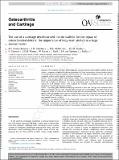| dc.contributor.author | Vindas Bolaños, R.A. | |
| dc.contributor.author | Cokelaere, S.M. | |
| dc.contributor.author | Estrada McDermott, Juan M. | |
| dc.contributor.author | Benders, K.E.M. | |
| dc.contributor.author | Gbureck, U. | |
| dc.contributor.author | Plomp, S.G.M. | |
| dc.contributor.author | Weinans, H. | |
| dc.contributor.author | Groll, J. | |
| dc.contributor.author | van Weeren, René | |
| dc.contributor.author | Malda, Jos | |
| dc.date.accessioned | 2020-05-29T20:49:50Z | |
| dc.date.available | 2020-05-29T20:49:50Z | |
| dc.date.issued | 2017-03 | |
| dc.identifier.uri | http://hdl.handle.net/11056/17471 | |
| dc.description.abstract | Objective To investigate the effect of decellularized cartilage-derived matrix (CDM) scaffolds, by itself and as a composite scaffold with a calcium phosphate (CaP) base, for the repair of osteochondral defects. It was hypothesized that the chondral defects would heal with fibrocartilaginous tissue and that the composite scaffold would result in better bone formation. Methods After an 8-week pilot experiment in a single horse, scaffolds were implanted in eight healthy horses in osteochondral defects on the medial trochlear ridge of the femur. In one joint a composite CDM–CaP scaffold was implanted (+P), in the contralateral joint a CDM only (−P) scaffold. After euthanasia at 6 months, tissues were analysed by histology, immunohistochemistry, micro-CT, biochemistry and biomechanical evaluation. Results The 8-week pilot showed encouraging formation of bone and cartilage, but incomplete defect filling. At 6 months, micro-CT and histology showed much more limited filling of the defect, but the CaP component of the +P scaffolds was well integrated with the surrounding bone. The repair tissue was fibrotic with high collagen type I and low type II content and with no differences between the groups. There were also no biochemical differences between the groups and repair tissue was much less stiff than normal tissue (P < 0.0001). Conclusions The implants failed to produce reasonable repair tissue in this osteochondral defect model, although the CaP base in the −P group integrated well with the recipient bone. The study stresses the importance of long-term in vivo studies to assess the efficacy of cartilage repair techniques. © 2016 Osteoarthritis Research Society International | es_ES |
| dc.description.abstract | Objetivo Investigar el efecto de los andamios de matriz derivada de cartílago descelularizado (MDL), por sí mismo y como andamio compuesto con una base de fosfato de calcio (CaP), para la reparación de defectos osteocondrales. Se planteó la hipótesis de que los defectos condrales sanarían con tejido fibrocartilaginoso y que el andamio compuesto daría como resultado una mejor formación ósea. Métodos Después de un experimento piloto de 8 semanas en un solo caballo, se implantaron andamios en ocho caballos sanos en defectos osteocondrales en la cresta troclear medial del fémur. En una articulación se implantó un andamio compuesto CDM-CaP (+ P), en la articulación contralateral un andamio CDM solo (−P). Después de la eutanasia a los 6 meses, los tejidos se analizaron por histología, inmunohistoquímica, micro-CT, bioquímica y evaluación biomecánica. Resultados El piloto de 8 semanas mostró una formación alentadora de hueso y cartílago, pero un relleno de defecto incompleto. A los 6 meses, la micro-CT y la histología mostraron un llenado mucho más limitado del defecto, pero el componente CaP de los andamios + P estaba bien integrado con el hueso circundante. El tejido de reparación era fibrótico con alto contenido de colágeno tipo I y bajo contenido de tipo II y sin diferencias entre los grupos. Tampoco hubo diferencias bioquímicas entre los grupos y el tejido de reparación fue mucho menos rígido que el tejido normal (P <0,0001). Conclusiones Los implantes no lograron producir tejido de reparación razonable en este modelo de defecto osteocondral, aunque la base de CaP en el grupo -P se integró bien con el hueso receptor. El estudio destaca la importancia de los estudios in vivo a largo plazo para evaluar la eficacia de las técnicas de reparación del cartílago. | es_ES |
| dc.description.sponsorship | Universidad Nacional, Costa Rica | es_ES |
| dc.language.iso | eng | es_ES |
| dc.publisher | Osteoarthritis and Cartilage | es_ES |
| dc.rights | Acceso abierto | es_ES |
| dc.rights.uri | http://creativecommons.org/licenses/by-nc-nd/4.0/ | |
| dc.source | Volume 25, ISSUE 3, P413-420, March 01, 2017 | es_ES |
| dc.subject | CABALLOS | es_ES |
| dc.subject | ENFERMEDADES OSEAS | es_ES |
| dc.subject | REGENERACIÓN BIOLÓGICA | es_ES |
| dc.subject | CARTILAGE | es_ES |
| dc.subject | SCAFFOLDS | es_ES |
| dc.subject | EQUINE MODEL | es_ES |
| dc.title | The use of a cartilage decellularized matrix scaffold for the repair of osteochondral defects: the importance of long-term studies in a large animal model | es_ES |
| dc.type | http://purl.org/coar/resource_type/c_6501 | es_ES |
| dc.description.procedence | Escuela de Medicina Veterinaria | es_ES |
| dc.identifier.doi | https://doi.org/10.1016/j.joca.2016.08.005 | |


